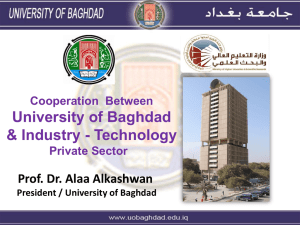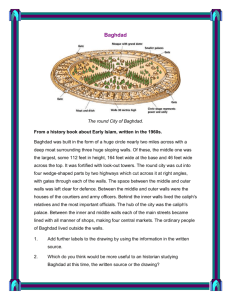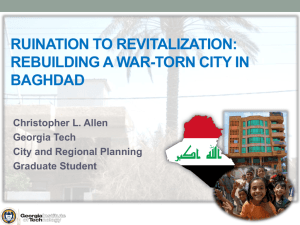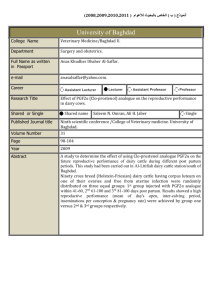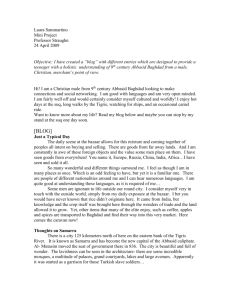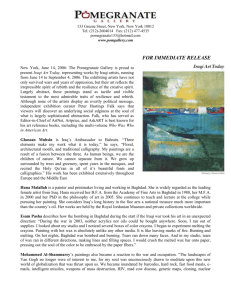1_Dr. Mohammed Qasim_continuity between academy and practice
advertisement
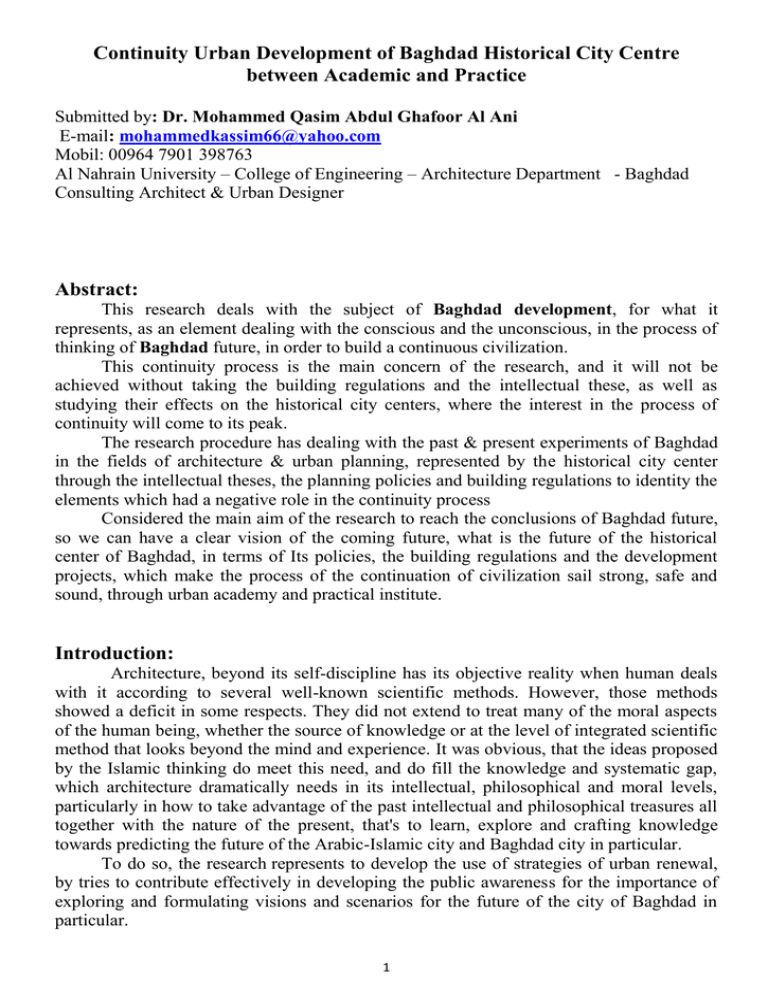
Continuity Urban Development of Baghdad Historical City Centre between Academic and Practice Submitted by: Dr. Mohammed Qasim Abdul Ghafoor Al Ani E-mail: mohammedkassim66@yahoo.com Mobil: 00964 7901 398763 Al Nahrain University – College of Engineering – Architecture Department - Baghdad Consulting Architect & Urban Designer Abstract: This research deals with the subject of Baghdad development, for what it represents, as an element dealing with the conscious and the unconscious, in the process of thinking of Baghdad future, in order to build a continuous civilization. This continuity process is the main concern of the research, and it will not be achieved without taking the building regulations and the intellectual these, as well as studying their effects on the historical city centers, where the interest in the process of continuity will come to its peak. The research procedure has dealing with the past & present experiments of Baghdad in the fields of architecture & urban planning, represented by the historical city center through the intellectual theses, the planning policies and building regulations to identity the elements which had a negative role in the continuity process Considered the main aim of the research to reach the conclusions of Baghdad future, so we can have a clear vision of the coming future, what is the future of the historical center of Baghdad, in terms of Its policies, the building regulations and the development projects, which make the process of the continuation of civilization sail strong, safe and sound, through urban academy and practical institute. Introduction: Architecture, beyond its self-discipline has its objective reality when human deals with it according to several well-known scientific methods. However, those methods showed a deficit in some respects. They did not extend to treat many of the moral aspects of the human being, whether the source of knowledge or at the level of integrated scientific method that looks beyond the mind and experience. It was obvious, that the ideas proposed by the Islamic thinking do meet this need, and do fill the knowledge and systematic gap, which architecture dramatically needs in its intellectual, philosophical and moral levels, particularly in how to take advantage of the past intellectual and philosophical treasures all together with the nature of the present, that's to learn, explore and crafting knowledge towards predicting the future of the Arabic-Islamic city and Baghdad city in particular. To do so, the research represents to develop the use of strategies of urban renewal, by tries to contribute effectively in developing the public awareness for the importance of exploring and formulating visions and scenarios for the future of the city of Baghdad in particular. 1 The city with forward-looking specialist interested in policy development strategies in the face of massive patterns of changes and transformations and challenges of our time, which became the privilege of the era of future industry and preparing for it and indicate its features before it goes into the womb of our present, through the formulation of appropriate frameworks to be prepared to confront it. Study and analysis of proposals that addressed the concepts of (continuity Urban development of Baghdad historical city centre between academic and practice) in the context of changes in the structure of intellectual, is by defining the dimensions of a strategy to predict the physical by communicating with the heritage and zeitgeist, On the face of paradox witnessed by Arabic architectural practice and local communities due to the absence of clear framework for the strategy of urban renewal to predict the future of Baghdad in the face the problem of identity and privacy of Islamic urbanism, this problem led to the emergence of the research objective, by Contribute effectively to the development of architecture opinion aware of the importance of exploring and formulating visions and scenarios for the future of strategy of urban renewal in urban planning & urban design in the historical city center of Baghdad . The research stands on the study of theoretical and practical concepts and principles of urbanism and it’s reflection on policies and strategies to the formation of urban planning and career of Arab-Islamic city. Then display critical study of the experiences of Baghdad city through its development plans and goals in the future, inferred from the most important principles and standards of planning and design adopted and the outcomes and how to use them, and their applicability to the city of Baghdad, through the study of the physical fabric of the city and its future, by cognitive science, and the application of analysis approach of the strengths, weaknesses, opportunities, and thirst (SWOT analysis) of this fabric in order to identify potential opportunities and potential obstacles that characterize the case of the city under study. According to the research methodology will be analyzed two groups of Baghdad district classified as follows: 1: The built up district (historical city center) and could be called cooperative urban group. 2: The manufacturer district (greater Baghdad) and could be called competitive urban group. Baghdad historic city center The historic center of Baghdad is represented by the 2 districts: Al Karkh & Al Rusafa. Both districts are situated via-á- vies on each Tigris river side. The bigger district Rusafa represents the central business district of the city of Baghdad (CBD). These two districts are exemplary for the strategic meaning and development of the culture and heritage of the city of Baghdad through its long history. So, in order to conserve and Revival historical cities, we need to analytic three stages of city developing: 1- Emerge stage - Growth stage 2- Urban planning stage, Urban design project to develop center 3- Building regulation, urban planning management stage 2 Historical renewal of Baghdad- Redevelopment, rehabilitation and conservation 1- Emerge stage - Growth stage Historical evidence suggests that the antique and archaeological information in the region of Karkh and Rasafa tracing back to the civilization Tel Harmel (Shadrubm) in the Kingdom of Ashnuna and will dated back to the late third millennium BC. As it shown below the most important dates in the history of Baghdad, as follows: Gregori Incidents witnessed important historical center of Baghdad an Date (AC) 762 Al-Mansur founded the city on the western side 836 Transmission of the Abbasid Caliphate of Baghdad to Samarra, which had in consequence the downfall of Baghdad. 892 Baghdad was again the capital of Caliph Al Moatamed and the urban life and residences concentrate on the eastern side and changed the significance of the west side of the Tigris River. 1055 At the beginning of the Seljuq aera and in Rusafa three bridges of boats were constructed and linked to Karkh. Furthermore some of the surrounding walls were constructed for protection Rusafa. 1089 Initiation of the establishment of the Great Wall of Baghdad and the construction was finished after 28 years. 1226 Construction of Al Abasi palace 1232 Construction completed of the school Mustansiriya. 1258 Occupation of Baghdad by Hulako and stopping the Abbasid rule 1729 Construction of fence along the western Baghdad 1766 As indication of the beginnings of the British influence in Baghdad the first British house was constructed of a British High Commissioner. 1853 best survey of the Ottoman period by Felix Jones, creation of a map of most urban and architectural buildings and districts and both river sides, according Mr. Jones map Rusafa consisted of 63 locations, 306 avenues, 55 mosques, 47 markets/suqs, 39 Khans. Karkh included 10 stores. 1860 In the late Ottoman period some major changes taken place in the city especially the rule of Namik Pasha and Midhat Pasha implemented a lot of urban changes into the historic city center in the spirit of “Western Inspired Modernization”. 1869 Midhat Pasha initiated the demolition of the wall and the latest changes in local and various economy and he opened the city for the expandsion outside the surrounding wall for the first time after 800 years. The demolition of the wall is an important step in the city development. 1917 Opening of the Al-Rashid Street which is a key indicator of the Western-oriented modern road network. 1918 Construction ot a bridge which conntected Rusafa and Karkh as 3 1921 1928 contact point between both of them. Establishment of the Kingdom in Iraq under the British Mandate, which is a turning point in the history of Baghdad. The establishment of the location of Sinak that rely on the rectangular planned to suit the changes in traffic means of transport, which includes mechanical and architectural style and urban access technologies and materials for new building construction, which represents a significant shift across the city. 2- Urban planning stage, Urban design project to develop center This stage remark emerging of urban planning development for Baghdad, and most important milestone in this field: 1936 Two German engineers prepared a first outline as the basis for the city of Baghdad. The strongly confirmed and planned construction included the planning of new wide roads through the urban fabric with high density in Rusafa and creation of commercial streets which would be similar to in the streets in Europe. Two of these roads were constructed during the textile district (Alkifah and Sheikh Omar Streets). In Rusafa the Al-Rashid Street contains three lanes and going in a balanced manner and along the Tigris River. They were changed in the direction of the movement and traffic in Rusafa and assisted trough street in 90 degrees. 1938 Opening of the bridge of Al Shohdai who was sited instead of Al Mamun old floating bridge. 1940 Opening of Al Ahrar bridge which was called Mode Bridge. 1954 The Kulafai Streetwas expanded after increasing private cars after the oil boom as a result of the economic boom. Rusafa was divided into five parts written as isolated length of 3 km and a width between 400 - 600 m. 1956 1st general master plan was created by a Britain planning office which intensives the one family concept and separating working, living and free time on the south gate with Hotels, cinemas and cafes and on the north gate a medical centre created 1958 2nd general master plan was created by a Greek planning office Doxiadis and the concept was for expansion up to 3million inhabitants 1962 first steps to save the old central city, the pressure increased during the revolution and the development of the city suburbs of Baghdad, The development accompanied by preparing plans to redevelop the Rusafa and Karkh sector as the Central Business (CBD). 1967 A comprehensive development plan for Baghdad 2000 was created by the consulting company Polish (Polservice) 1973 The comprehensive development plan of Paul Surfs was revised to revitalize Karkh and Rusafa as central areas of the capital Baghdad. 1973 The implementation of the July 17 bridge project to link the Karkh Rasafa and the establishment of a route to a Al Talaei square. 4 1980 The preparation of a detailed study of transport in Baghdad by Baghdad municipality. 1981 The Haifa Street project started and was accomplished in 1985 1981 Baghdad Metro project planning has not been implemented. 1982 Provision of the comprehensive development proposals planned for Baghdad, 2000 1982 Completion of a Study-Karkh Development project and proposed by the Office of Alusi Technical Consultants 1984 Studying the development of the Rusafa area by the Consultative Japanese JCP 1985 Comprehensive development strategies by Japanese JCCF consultants and Baghdad Secretariat. 1986 Comprehensive inventory of heritage buildings for Rusafa. 1987 Planning of integrated development of the city of Baghdad, 2001 and outlines a proposal for developing the river front by the Consultative Japanese JCCF but no implementation so far. 1988 Baghdad Municipality issued a set of controls for construction and planning division of the land in the city of Baghdad. 1994 Study the preservation of buildings of heritage and the role of the Rusafa by the University of Baghdad. 1998 Urban development project for the city of Baghdad (2015) Phase 1 by the Secretariat and the University of Baghdad 2000 Urban development scheme for the city of Baghdad (2015) Phase 2 by the Secretariat and the University of Baghdad 2010 Comprehensive development planning Baghdad (2030) by Qateeb & Alame and PCI Japanese consultants and Baghdad Secretariat. A- Baghdad general master plan - Doxiadis Association 1958 In 1955 the Iraqi re-habilitation council was established and ordered a company to start a new comprehensive plan for Baghdad, moreover they cooperated with Doxiadis Bureau, a famous urban designer company, to submit the vision to redevelop Baghdad and other cities in Iraq. Iraq was a constitutional monarchy until 1958 as a group of army officers overthrew the government and proclaimed the first Republic of Iraq. The Doxiadis office prepared many planning concepts for the urban development for a lot of sectors in Baghdad and further cities in Iraq. The reason was the fast growth of slums in the east side of the city to inhabit more than 400.000 migrant coming to Baghdad from southern cities. In relation to the whole work the most significant example will be presented of the urban development Al thawra city. And he raised his famous slogan: ”The module in new city should be the sector instead of the block“ (City Black ). But the proposed urban development plan in 1959 was rejected by the government for Baghdad. 5 B- A comprehensive development plan for Baghdad 2000 (Polservice)- 1973 In 1967 another consultation company was named to prepare a new study for a comprehensive plan for Baghdad it was the Polservice company. In 1973 the same company asked to prepare the regional plan for Baghdad, as the oil boom of the 1970s brought wealth to Baghdad and the city was developed to an impressive scale. The city stretches along both banks of the Tigris with the district of Rusafah on the east and the district of Karkh on the west side. Eleven bridges connect the two halves of the city with a total population of 5 million people. This planning concept is considered now as the last comprehensive plan approved for Baghdad which was a very clear and a successful vision for Baghdad and we can observe the deep influence of this study in the structure of the city today. But unfortunately many of this study guidelines was overthrow in reason of the complicated situation faced the country after the first and second Gulf wars. Different zones definition for the Region Baghdad: 1. Inner City - 12-15km 2. Baghdad suburban zone - 25-30km 3. Buffer zone - Agricultural belt- 50-60km 4. Outer regional zone - 100-120km C- Integrated development Plan of Baghdad 2001 JCCF - 1987 JCCF prepared by the Japanese company in 1987 but did not initiate, and formulated the goals of the company's plan from the city of Baghdad, a city regarded as the most important and the heart of Iraq's political, financial and cultural influence in its direction on Iraq as a whole. And the city as an open system affects and is affected by the movement of Iraq. Based on its studies and found that the growth of Baghdad is progressing faster than the growth of other urban areas, increasing the pressure on them. The main reason for this is because of the attractiveness of migration to it in terms of services and employment opportunities. JCCF Have been identified the main goals of the study, as follows: • Delay the rate of growth quantitative measurements to reach the population, the goal in 2000 and to achieve balanced development. • Encourage the development of activities suitable for a large Arab city of Baghdad. • Do not encourage or directed activities that reduce the quality of urban development. • Encourage the private sector style is direct, through laws and regulations to play a bigger role in development. As for the center of Baghdad, has reviewed the historical background, which was planned in an era not far beyond the region is not the traditional old in each of the Rusafa and Karkh, this small area was the beginning of the city to provide sufficient space required for the functions of administrative and commercial residents of the city. But with the pressure of population growth and the aspiration to modernize the old center city began in parallel to the Tigris River, and could be called a belt of the Tigris. But the construction of Damascus Street in the Karkh gave a new dimension perpendicular to the direction of the river belt. 6 The proposed integration development plan outlines are to develop the river front in terms of environmental (clean the banks of the river) and aesthetic (entertainment, etc). and construction (the strengthening of embankments and structures to prevent erosion) and functional (use of river transport). With the development of the See of East Street in the Rusafa become a great potential for expansion of the east where it has some government buildings and commercial interests, business and thereby expanded the city center five times its size when it was in the old traditional area in each of the Rusafa and Karkh. This study is based on four alternatives for growth: 1. The principle of Growth poles: This means to focus development efforts towards the two cities to three cities outside Baghdad attract additional regional priority. 2. The principle passages Urban Corridors: the organization of development across the different axes. 3. The principle of Dispersed settlements: the distribution of urban development across the regions secondary to central Iraq on urban settlements, large and small. According to the balance of population density and stability of the rates of immigration, and depends on the strengthening of a developmental elected during the early stages and these nodes can be acquired with time dynamics of a mission to become the poles and begin to gradually take the part of the role played by the largest city in the region (Baghdad). At present, most of the settlements in Iraq have direct links with the capital, but within the proposed principles, the smaller towns will be linked directly to cities, the largest within their territories, the smaller of the hierarchy of settlements, where the link and nationality of the capital is determined by only the functions and services the most specialized and toplevel. 4. Moderate Disparate: basics and be effective a / inhibits the growth of the city of Baghdad, rising slowly. in two cases: b / configure solid economic growth points to growth through a wide range of employment opportunities, benefits and services the city of Baghdad or the standards of the best of them with a balanced range of education and health services, cultural services and communication distinct. Rural areas better to retain the rural character and ownership of modern agriculture with traditional events. These points will not be effective unless it is scaled investment in the city of Baghdad, with increased investment in growth points, for the purpose of establishing a balance in development to the north and the south and west of Baghdad for a major and accelerating growth in the outer most of the procedure. To reach ten developing poles of urban growth in the greater Baghdad, and eight rural developing areas. Although the outlet of the planned integrated development with respect to parallel axes of movement the main river in the center of the city (after it was in the past perpendicular to the river), and how to deal with the river's edge, but the plans overall development of integrated task in the development of the city as a whole at the level of the totalitarian and development center city on the local level, which is much better than the charts that show the basic uses of the land. As the problem of Baghdad and its historic center is the dependence on the basic plans left by the most developed countries and non-application of integrated development plans so far. 7 D- Comprehensive development planning Baghdad 2030 - Qateeb & Alame and PCI Japanese consultants - 2010 In 2010 Baghdad municipality contract with Qateeb & Alame and PCI Japanese consultants, in order to reach the goals of Comprehensive development planning Baghdad 2030. The objective of the project development plan of the city of Baghdad, deal this city as an integrated environment includes all aspects of social, economic, environmental, administrative, and other aspects, beyond the current building to meet the needs of their citizens. This overall vision will enable to achieve the development Baghdad perspective conceptual and technical again, so that this advanced approach in planning is able to reconcile the economic, political, physical, environmental, and activate the city in order to prepare strategies and actions to achieve the goals and objectives of the plan from a technical point, and will be using the latest reached by the GIS technology as a powerful tool for the diagnosis of conditions past and present in Baghdad, and propose strategies, the priority is to: • Dealing primarily with the role of Baghdad, at the national, regional and international issues of common management and urban renewal within the administrative boundaries. • Includes a series of strategic interventions in the fabric of the city. • Take into account the relationship between the center of Baghdad and its immediate environment, as well as between the city of Baghdad and its suburbs adjacent to it, especially for projects that are currently being implemented there. • Study the rehabilitation and urban design within the city of Baghdad. This plan will propose as a totalitarian system that uses GIS techniques to integrate the needs of the city with the management of urban development, social and economic conditions for its citizens and their needs anticipated. This link will bring urban development advanced and comprehensive. Basic development priorities design of the currently approved in the city, as well as by the gaps, such as the development of conservation areas and recreational areas and industrial areas. The war produced an urban transformations have led to the disintegration of multi-structural in the city and encouraged the growth of random addition to weak institutional initiatives in urban development and urban. As a result, the condition, Baghdad today is characterized by the following: - Deterioration of the urban fabric. - Review of land use. - To contain the phenomenon of informal settlements. - Inadequate networks of basic services and infrastructure. - Inadequate road network and transportation systems. - Inadequate public services and social infrastructure. - Deterioration in the urban built environment. - Housing deficit accumulated as a result of population growth, instructions and regulations restricting development. - The inefficiency of a strategy of economic development and employment generation. - The need to treat the capital Baghdad, with the ability to deal with potential regional investments in various sectors. The functions of the draft comprehensive development plan for the city of Baghdad in 2030, consists of and focusing on the following elements: 8 1: land use, planning, management of growth. 2: The environment. 3: Natural resources in and outside the city, entertainment, social resources. 4: The historical and cultural resources. 5: Housing. 6: Transport. 7: Infrastructure services. 8: The development of the economy. 9: Guiding principles for urban design. Although the Comprehensive development planning Baghdad 2030 complete the first stage and prepare for second stage, but it is important for a new study for developing of greater Baghdad, and historical city center till now not appears with details. E- Development project Rusafa - Japanese Consultants JCP in 1984 With (Dr.Stefano Bianca, Mr. Sohiko Yamada, Dr. Ihsan Fethi, Prof. Giorgio Lombardi) In 1984 the Japanese JCP started the research studies in Rusafa. One of the key facts and whishes of the consultants were to find out an optimal balance in the development of the structural design for the future of Rusafa between the different urban structure types. In different detailed research plans the solid bases is shown for the balance between conservation and development. Important was the presentation of the important components like urban regulations, process controlling and control in the development. A detailed analysis of the existing conditions of the field of study has resulted in the definition of some general goals. These affected directly the planning process and various strategies and named as: - Development of the historical city center which will be qualified as capital of Iraq. - Re-integration of urban structure which shattered the ancient city. - Maintaining the historic fabric and boulevards. - Navigation and organization of urban development in areas according to modern standards and controls of urban design. The research and development team identified five major spines in the historical district Rusafa with the point of view to the pedestrians. The planning proposed to maintain and developing vital roads in the organic structure of the ancient city. After the situation diagnose the created plans summarized the following areas: Section Wastani / Castle length in 2000. section Wastani / markets along in 2200. Bab enchantment / Sinak length in 1600. Kilani / field length in 2500. Field / Street Mustansir length in 1700. The markets represent an essential element of traditional urban life for Baghdad. So the target is to reintegrate the architectural value of the market system and restore the central axis for example the direction beginning on the river side nearly the Al Shohadai bridge till al-Kilani mosque. The plan proposed the maintenance and rehabilitation of various markets and landmarks such as mosques, boxes, public baths. In addition they fit the changes in these 9 areas need to excellent business in increasing the energy storage and improved access without changes in the nature of walkways or a human scale. We find that the consultant's Japanese JCP study is an extensive and detailed study focused on preserving more of the development ... Although this study is approved for the Rusafa district of Baghdad. The Municipality grants the building permits, but it does not represent the controls of planning and design. In reason of misapplication of the study's recommendations by the executive bodies in Baghdad, the Municipality has minimized the success of the study as more enrichment. In the JCP research study was one of the key facts and wishes to find out an optimal balance in the development of the structural design for the future of Rusafa between the different urban structure types. A detailed analysis of the conditions resulted in general targets: Development of the historical city centre to qualify it as capital of Iraq. Re-integration of urban structure which shattered the ancient city. Improvement of environmental conditions Organization of urban development according to modern standards and controls of urban design. Theses were affected directly in the planning strategies: 1. Historical fabric conservation Integration broken urban structure after analyzing the historical urban fabric Conservation and revitalization Development schemes for future implementation to protect the cultural identity Maintaining the historic fabric and boulevards 2. Urban design Providing structure plan as an integral part of Baghdad Balance between conservation and modern development through definition of new guidelines Pressure reduction of the old fabric through offering development opportunities Division Rusafa in 6 zones with different functional developments 3. Functional /Transportation development Improvement the mixed land use Limitation the extension of CBD and proposition a new traffic policy to reduce the pressure on the historical sites. Development around the historical city in southern Rusafa for creation a transition zone Expansion the communal functions (residential, open space...) to 200% from 19802000 Proposition to expand CBD function to 189% Proposition to minimize industrial functions to 74% F- Karkh Development Project - Office of Alusi technical advice in 1982: By consultants (Maath Alous, Manfred Muller, Dr. Kristin Ammann). The historical district was exposed to large changes in the traditional fabric as a result of large development projects in Karkh. The first was the implementation of a project 10 for construction the bridge July 17 and to set up a route to the Al Tallai Street in 1973. This was followed by the implementation of the project Haifa Street in 1981 and followed by planning the Metro Project Baghdad, which has not been implemented yet. These project were aimed to develop Karkh (proposed by the Office of Alusi Technical Consultants in 1982 and adopted by the Municipality of Baghdad) to maintain the old fabric according to the recent development of the area mentioned above ... It also aims to integrate the Haifa Street project completed and the adjacent parts of the old fabric. Emerged as a clear vision within the developing project of Karkh the architectural heritage in Baghdad was one of the main points and was limited at the beginning in two apartments in the district: Al Shawaka & Al Kremat. But this concept has expanded gradually until it became as a general principle in the development of the region. And the challenge of the project is how to maintain the existing renovation or rehabilitation rather than removed. This method is fast, easy and low cost compared to re-development as well as the prevailing social relations. The project is based on the development of Karkh on four points: 1. Emphasis on the residential character of the area. 2. Basis on commercial activities as part of the central business district of the city of Baghdad. 3. Providing work opportunities in the region. 4. Haifa Street Development is an urban planning in the newly integrated region. But the proposal has produced some of the most important points: - Proposed traffic to keep the current status of development, exception for a street separating the commercial area of the residential area in Al Shawaka Street and connection with Imam Musa al-Kadom (peace be upon him) which may be cause congestion of the Al Shohadai bridge in absence of any specific solution for this region. - Trying to maintain the pattern of the methods used existing firstly and in thinking of the passengers and the urban heritage. - Based on the principle of separation of commercial activities on the cultural events and entertainment. - The traditional opening of the market to the river with a large interface and coming in some parts inside to relive the most powerful river. - Dealing with this region as a gateway to the Karkh district so a big entrance at the end of Al Shohadai bridge which means gate of al-Karkh history. After implemented important projects like Haifa Street and construction of the Bridge of 17th July the development project of Al Karkh was adopted by the Municipality of Baghdad. The architectural heritage in Baghdad was one of the main points. To reach general principles of the development: 1- Emphasis the residential character of the area 2- Basis of commercial activities as part of C.B.D 3- Provision new work opportunities 4- Haifa Street development as urban integrated planning 5- Opening to the river of the traditional market as large interface The planning indicated the different levels of cultural, social and economic development of the inhabitants of these regions and resulted many social problems. The study of Al Karkh development researched the possibilities of intergradations the Haifa Street in the urban structure. But this new urban style arose difficult problems which 11 cannot resolve without a comprehensive development of the region. But this proposed study has advantages and it is used in the Municipality of Baghdad for the granting of construction permits now. 3- Building regulation, urban planning management stage Urban Historical city centers problems, building regulations, impact of urban planning management and treatments According to the historical urban development therefore the historic center of Baghdad will be researched in a detailed view in the ancient wall. That was built in Rusafa in 482 H - in 1089 and in Al-Karkh, 1193 H 1729. After a short historical overview the research presents the different problems of the historic center of Baghdad which was significantly modified and degraded in the last 50 years. Urban management for the current Baghdad: is plagued by the current from several problems, such as land use problems, housing and population ... etc, but the show - and sharply - the problems of infrastructure, from electricity and water supply, sanitation and pollution, with significant impact on the city of Baghdad, in general, and the center the historic city in particular, namely: Population Density. Land use. Transportation network. Education facilities. Baghdad Health facilities. • Drinking water: the network in some areas that need rehabilitation. Network suffers from water pollution due to high sewage systems affected. • Sanitation: sanitation system requires a great deal of immediate action to accommodate the current flows generated and to reduce or eliminate the danger that threatens the health of the population in surrounding areas and the reduction of environmental impacts on the Tigris River and the surrounding environment. • Electrical power: suffers from many problems, including foot stations and damaged others and increase the demand for energy. • Communication networks. • Natural features. - Soil characteristics: Baghdad is in the plain of alluvial deposits of the basin of the Tigris River, where a good ground for the implementation of projects, urban development and agriculture and horticulture production, if provided in ways that modern irrigation. - Bodies of water: The River Tigris great natural gift of Baghdad, this river provide water for drinking and irrigation water for agriculture, horticulture and water used for industrial purposes and the axis represents the natural outlet for recreation and entertainment in Baghdad. - Green areas and entertainment: enjoy the presence of Baghdad municipality green agricultural areas surrounding the urban area and a source of valuable environmental and represents a natural outlet and lungs of the city of Baghdad. - Pollution: the city of Baghdad suffers from contamination in the groundwater and rivers, the Tigris and Diyala. It also suffers from air pollution, largely due to the large 12 increase in the number of vehicles in recent years. In addition the increased incidence of dust storms as a result of climatic and environmental changes at the country level. Transformation of the river edge from vertical to sloped. Change typology of traditional allies from vertical to the river to parallel. Transformation of building typology from small - low rise cells to mega structure with high rise. The mega structures cutting continuity of traditional allies. Foreign building regulation not related to local tradition. Destroyed the ancient walls surrounded the historical city center missing the identity and characters of Baghdad. Change the housing function to commercial make death of the historical city center in the night. Problems of urban development has been defined as: the indiscriminate proliferation, which can not be controlled, and complexity of the problems highlighted in the areas of commercial / mixed city center which contains commercial activities and intensive government, and inadequate attitudes and jams sharp for the passage of vehicles that are intertwined directly with the pedestrian traffic . Population distribution for C.B.D Population 1980 Total for Baghdad 1001 Rusafa % for bag. 1002 Karkh % for bag. Total C.B.D % for bag. 1985 1990 2000 2002 2006 3,376,600 4,122,950 4,724,050 4,965,500 6,222,186 6,902,842 258,700 7,7 % 245,200 5,9 % 227,600 4,7 % 190,000 3,8 % 130,200 3,9 % 141,100 3,1 % 144,150 3,1 % 129,650 2,6 % 388,900 11,5 % 386,300 6,4 % 364,750 7,7 % 219,650 6,4 % 7841 p/km2 Manpower distribution for C.B.D Manpower 1980 1985 1990 2000 Total for Baghdad 1001 Rusafa % for bag. 1002 Karkh % for bag. Total C.B.D % for bag. 655,500 903,950 173,600 20,5 % 216,150 23,9 % 1,165,05 0 242,450 20,1 % 1,525,90 0 253,050 16,6 % 53,600 8.2 % 277,200 34,7 % 74,650 8,3 % 290,800 32,2 % 96,550 8,3 % 339,000 29,1 % 127,500 8,3 % 381,350 24,9 % 13 2002 2006 Building regulations The most important dates in the urban regulation development are shown below. The current system is not based on the conditions and needs today, impact of urban planning, urban planning of today is guided by commercial and political groups interests Gregoria Important laws and buildings regulation n Date (AC) 1935 Legislation of the first building code as a system of roads and buildings, No. 44 based on British laws. 1964 Administration municipalities Law No. 165 as basic law of the work of municipalities including Baghdad. 1971 Law of the basic design of the city of Baghdad, no 156 1979 Revolution Command Council Decree No. 850, including the amendment of the minimum secretion residential land between 120 m 2 - 800 m 2 1983 Launch commercial streets in the city of Baghdad 1987 Revolution Command Council Decree No. 940 which amends the secretion of residential land and not less than 200 m 2 -800 m 2. 1988 Preparation of the proposed law in construction and urban planning of the city of Baghdad by the Engineer Ihsan Shirzad and English Baker Dyke Allen who is not prescribed. 1989 Revolution Command Council Decree No. 51 which provides the review of the basic design of the city of Baghdad. According to the directives that all stops the growing of the city without more increasing of the population density. Treatments and diagnosis Baghdad historical city center needs the ways of dealings with Architectural Heritage (Strategies of urban Renewal): 1- Redevelopment 2- Rehabilitation 3- Conservation So good management need Preparation of Alternative strategies: Temporary comprehensive development Control separated development Free separated development Although integration between Heritage & contemporary needs many Styles such as: - Imitation Harmonic integration Harmonic contrast Contrast 14 To Predict the Future Baghdad City according to the mechanism of the SWOT analysis of internal and external environment of the city of Baghdad, can search access to the following results: Strengthens: • Guide the State's policy for the use of information systems technologies and applications, and administrative climate. • Availability of financial and technical support for the development of human resources. • Interest of foreign institutions and donors that support and funding for such projects. • Development of curriculum planning to accept the technological development. • Possible provision of software and hardware of computers, which support the use of forward-looking technologies, systems analysis. Weaknesses: • Lack of network connectivity and communication between the institutions that support the IT system. • Do not accept some of the individual within the institutional structure to deal with modern technologies. • Still hardware and urban planning institutions are not fully aware of the forward-looking technology and its applications in the field of planning and urban design. • Lack of structure to informational databases, whether digital or spatial metadata. • There is no kind of standardization for both structural standards, and urban icons. • The system is still to urban management systems, the city needs to develop a substantial and sophisticated style to deal with their problems. • The traditional method is still in the Department of Urban Planning is used in urban institutions. Opportunities: • Availability of data and maps in digital form though not accuracy. • The need for a comprehensive strategy to support and improve the integration of administrative Organizational Integration. And implement development programs and applications of urban information systems, and geographical information such as a bank, because the data in the modern concept is the pool once with the possibility of use in many areas for several times. • Reduce the space within the unit statistical data collection of demographic, economic, and urban. • Improve the performance of human resources to deal with software servers for GIS and harness their potential and the analytical methods available to retrieve and display information. Threats: • Scarcity of skilled labor in the maintenance of heritage buildings and the road to include within the urban context. • Leakage of cadres trained in architecture to the outside diameter. • A sense of the overall scheme relying on computers in the number of planned without his knowledge to enter the human mental and experimental attack. • Rely on digital maps with information in general (two-dimensional) and the absence of the third dimension and the fourth dimension for urban development schemes, which directly affect the drafting of planning scheme. Through the analysis of the SWOT and test the framework of knowledge at hand to measure the dimensions of the identity of the cities of the future - according to the new 15 dimensions of cities - the application of the framework for the cities of the future in the city of Baghdad, showing qualities of identity, the future and reflects the transformations, beginning to recognize the different levels are different properties have, and styles that have grown , and the most important practices of planning for the city that are models for a change in the intellectual structure, and the end of a model for hypothetical scenarios for future planning of the city of Baghdad (a mechanism for the link and interaction between the effects internal and external influences and the new dimensions of the potential future of the city). References Alous, Maath; Muller, Manfred: Al Karkh Redevelopment Study: Baghdad Municipality, 1982. Al Ani, Mohammad Qasim: Nostalgia: Between Theory and Practice - Effects of Building regulations and Intellectual theses on the process of continuity for the historical city centers: Master thesis, college of Engineering, Baghdad university, 2001. Al mulaa hiweesh, aqeel, & Hayder; Contemporary Iraqi planning; Culture office, Baghdad, 1988. Al Ani, Mohammad Qasim: Urban Prediction - Towards a New Generation to Redevelop the Arabic- Islamic City; PhD thesis, college of Engineering, Baghdad university, 2011. Bianca, Stefano; Urban Form in the Arab World; Past and Present, 2000 Graf, Christina; About the historical development of Baghdad foundation until the 19th century; Berlin, Germany, 2010. JCCF, Japanese consultant ; Integrated capital development plan of Baghdad 2001 ; Baghdad Municipality, Baghdad, Iraq, 1987. JCP, Japanese consultant: Al Rusafa Redevelopment Project: Baghdad Municipality, 1984. Polsevice, consulting engineering; Comprehensive development plan for Baghdad -2000; Warsaw, Poland, Aug.1973. Qateb & Alame; The Comprehensive Development of the city of Baghdad in 2030; Baghdad Municipality, Baghdad, Iraq, 2010. Yasser Elsheshtawy, Planning Middle Eastern Cities, An urban kaleidoscope in a globalizing world, 2004. Warren, John, &, Fethi, Ihsan: Traditional Houses in Baghdad: Coach Publishing House Limited, Horsham, England, 1982. 16 Concept of multiple circles of greater Baghdad 2000 (Polsevice, 1973) Main historical spines of Baghdad historical city center (JCP, 1984) 17 Master plan of Baghdad 2000 (Polsevice, 1973) Master plan of Integrated capital development plan of Baghdad 2001 (JCCF, 1987) 18 Re development of Al Rusafa as part of Baghdad historical city center (JCP, 1984) Re development of Al Kurkh as part of Baghdad historical city center (Alalosi, 1982) 19 Land use in the Comprehensive Development of the city of Baghdad in 2030 (Qateb & Alame,2010) 20
